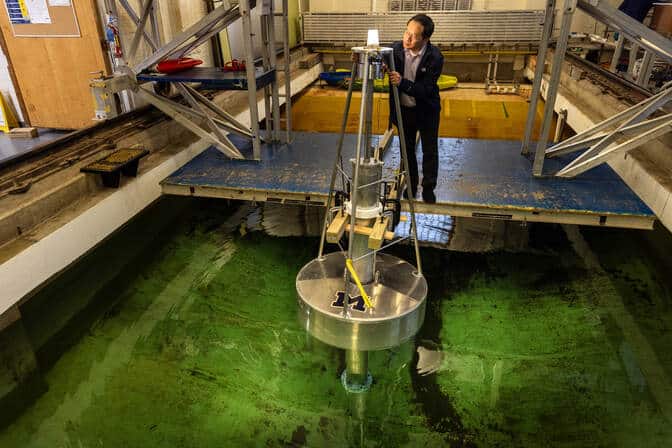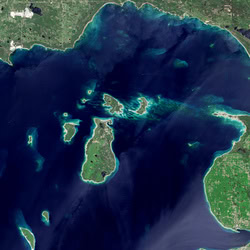
Unlocking ocean power: $3.6M for community-centric wave energy converters
Wave energy could power millions of homes, but to make a splash in the industry, the tech must balance engineering, socio-economic and environmental trade-offs.

Wave energy could power millions of homes, but to make a splash in the industry, the tech must balance engineering, socio-economic and environmental trade-offs.
Coastal communities are partnering with a multidisciplinary research team to determine the best way to harvest wave energy at Beaver Island, Michigan, and Nags Head, North Carolina.
The project is led by the University of Michigan, supported with $3.6 million from the National Science Foundation. It brings together researchers from five different institutions to help provide renewable energy that addresses the needs and concerns of coastal and island communities and identifies paths to make wave energy technology competitive with solar and wind power.
Waves are a vast source of untapped renewable energy. They could completely cover Alaska and Hawaii’s electricity needs and generate enough power along mainland U.S. coasts to keep the lights on in 130 million homes, or meet 35% of the country’s electricity demand, without any direct greenhouse gas emissions, according to the National Renewable Energy Laboratory.

Despite its promise, wave energy still can’t compete with wind and solar energy in today’s market because engineers haven’t settled on the best way to harvest it or assess the technology.
“Everybody knows what a wind turbine looks like because the research community has rallied behind a single idea,” said Jeff Scruggs, U-M professor of civil and environmental engineering and the project’s co-principal investigator. “For wave energy converters, that’s not the case. When you look at the devices that companies are deploying for their trials, they are nothing like each other. Everybody’s got their own idea about the best way to harvest wave energy.”
Companies and laboratories have tested a wide host of concepts: bobbing buoys, submersed devices, hinged rafts, paddles and more. Each comes with its own pros and cons. A device optimized for generating energy could be more prone to damage from storms or have more environmental risks than other devices, and there are no guidelines to determine which trade-offs are acceptable or economical.
“We need to develop a method to holistically assess wave energy devices, and that’s something that can’t be done by one person with one area of expertise working individually,” said Lei Zuo, the Herbert C. Sadler Collegiate Professor of Engineering at U-M, a professor of naval architecture and marine engineering and the project’s lead principal investigator.

The team will develop that assessment framework by getting community input from the start. For Beaver Island, wave energy might be a pathway to increased energy security and independence from expensive diesel for the island’s back-up generators. At Nags Head, wave power could provide emergency electricity after catastrophic events—like hurricanes—or power devices that remove salt from seawater during emergency scenarios when freshwater may have been compromised. But the researchers need the communities’ feedback to decide the best approach at each location.
“As researchers, we often think that communities are only recipients of our research. But coastal communities often know more about what is happening locally on the coast and about what is likely to work for their communities,” said Eric Wade, assistant professor of coastal studies at East Carolina University who will assess the project’s sociological impacts and co-lead community engagement.
Without that community-centric design, renewable energy projects are likely to face terminal pushback. In a recent example, an offshore wind energy project off the coast of Cleveland, Ohio, recently ended due to challenges from residents and environmental groups who feared damage to wildlife and treasured views.
“All of the research to date indicates that wave energy isn’t likely a high risk to marine life compared to climate change, but because we don’t have enough deployments to really know what the risks are, it’s hard to make that case to regulators,” said Lindsay Dubbs, research associate professor at the University of North Carolina’s Institute for the Environment, who will lead the project’s environmental risk assessments. “That has certainly prevented some marine energy devices from being permitted and deployed in a timely manner.”
Additional team members include: Danesh Tafti, professor of mechanical engineering at Virginia Tech; Daniel Deng, U-M adjunct professor of naval architecture and marine engineering and laboratory fellow at the Pacific Northwest National Laboratory; Gail Gruenwald, a member of the Beaver Island Association; and Bill Staby, founder of Blue Water Network LLC.
Zuo is also a professor of mechanical engineering, and Scruggs is also a professor of electrical and computer engineering. Wade and Dubbs are both affiliated with the Coastal Studies Institute.

Marketing Communications Specialist
Department of Civil and Environmental Engineering